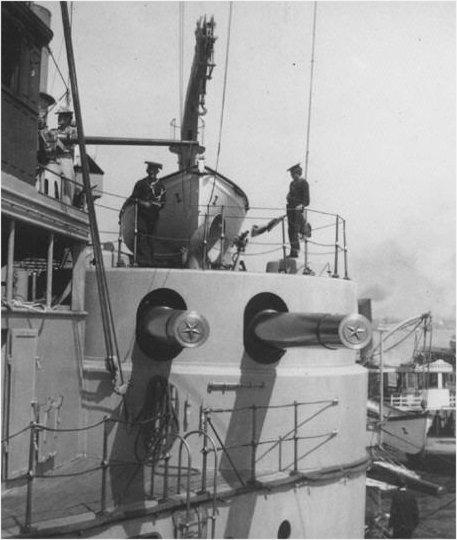|
During the Battle of Manila Bay in 1898, USS Olympia fired an 8" (20.3 cm) shell from one of her 8"/35 (20.3 cm) guns that struck the Spanish flagship Reina Christina "squarely in the stern and drove through the length of the ship, rending every obstruction, wrecking the aft boiler, and blowing open the deck in its explosion. This one shell proved the flagship's fate" - Ivan Musicant in "U.S. Armored Cruisers." The 8"/35 (20.3 cm) Mark 3 gun barrels intended for Brooklyn (ACR-3) and Iowa (B-4) were initially rejected by the Bureau of Ordnance, as they were honeycombed with small "sand splits," a result of the excessive amounts of clay and slag used in the gun metal. However, after a delay of two years, they were accepted at a reduced cost. Three of these guns on Iowa subsequently blew off their muzzles during a gunnery exercise in 1904 - see photograph on additional pictures page. The Mark 3 had 11 hoops. One gun, designated Mod 3, was lengthened to 40 calibers. The Mark 4 was similar but with the trunnion hoop and elevating band removed, with the threads formerly under the trunnion hoop being continued to the rear of the gun, which allowed it to be screwed into the sleeve of a two-gun turret mount. One gun, designated Mod 10, was cut down to 23 calibers for experimental work with high-explosive shells. Mark 5 was a new 40 caliber design intended for armored cruisers and battleship secondaries. Unfortunately, the Mark 5 proved to be unable to handle the transition from black to brown powder, as the new propellant burned more slowly, which allowed pressure to build up to unsafe levels as the projectile traveled down the bore. This problem was illustrated when USS Colorado (ACR-7) blew off the muzzle of one of her 8" (20.3 cm) guns during a gunnery exercise off Chefoo, Shantung, on 22 June 1907. All Mark 5 guns were subsequently removed from service, rehooped to the muzzle and then placed in reserve. Most of these ships were then rearmed with the stronger 8"/45 (20.3 cm) Mark 6. |

8"/35 (20.3 cm) mount on USS Indiana B-3
sometime in the 1890s
|
| .
|